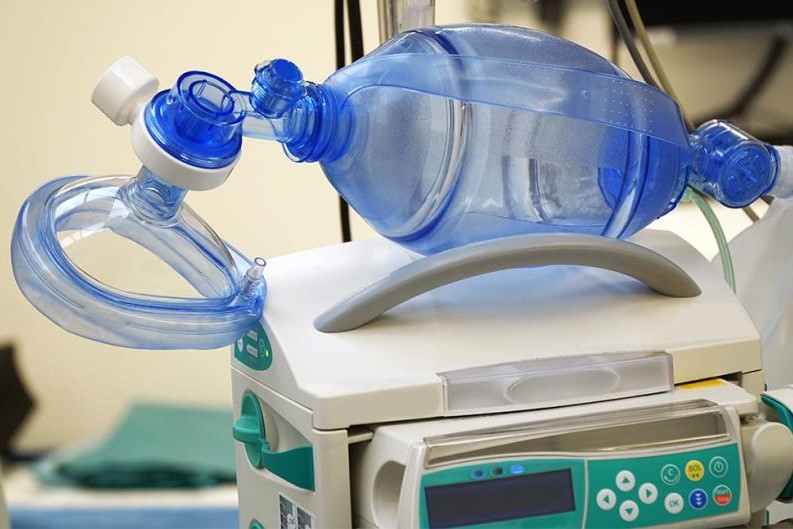
Ambu bag: characteristics and how to use the self-expanding balloon
The Ambu ballon, from the acronym Auxiliary Manual Breathing Unit, is a self-expanding flask used to support respiratory activity. The acronym was created by the company that first put it on the market in 1956
It is one of the most widely used instruments in emergencies both as a manoeuvre in resuscitation and to support breathing in patients with insufficient lung ventilation.
The instrument is highly recommended to be used connected to oxygen in case there is a need to maximise the oxygenation of the patient.
Let’s find out more about the characteristics and how to use the Ambu bag.
Ambu ballon: characteristics
The Ambu resuscitation bag is an instrument consisting of a self-expanding plastic bag connected at its ends to two one-way valves.
One of these valves allows air to enter the inside of the balloon, the other valve directs the air outwards.
This prevents rebreathing, which involves inhaling exhaled air.
At the proximal end, the Ambu resuscitation balloon is equipped with a universal 15 mm long connector to ensure connection to various airway management devices such as masks, endotracheal tubes, tracheostomy cannulae, HME filters, catheter mounts.
A feature of self-expandable balloons is that they are available in various sizes, so that they can be adapted to different face shapes, and that they can be fitted with an oxygen cylinder and/or reservoir.
The latter consists of a balloon where oxygen accumulates without waste while waiting to enter the self-expanding balloon for subsequent insufflation.
In ambu ventilation of a patient who already has an invasive way of breathing installed, an HME filter must be connected before connecting the self-expanding balloon to the device.
This device provides air heating and humidification.
In addition, it is also recommended to use a corrugated tube for better ventilation, so that the device used to manage the airway is not under tension.
This prevents extubation, which can occur due to the tube being under tension.
If the patient does not have an invasive airway, ventilation can be carried out using a face mask.
This is placed over the mouth and nose so that they are both covered and allows air to enter the pulmonary tree.
How to use the Auxiliary Manual Breathing Unit (Ambu)
After attaching the Ambu self-expanding balloon to the patient, the operator compresses the balloon to generate a higher pressure inside than atmospheric pressure.
While this maneuver is performed, a flow of air is generated which allows the proximal one-way valve to open and the distal one-way valve to close, sending the flow to the patient.
When the balloon is released, the negative pressure created inside generates the opposite effect on the valves and closes the proximal valve while the distal one opens.
In this way the balloon can be refilled.
To use the Ambu bag, proceed as follows:
- The rescuer places the mask on the patient’s face, making sure that the edges fit snugly around the skin around the mouth and nose.
- The mask is placed on the person’s face by performing an “EC” manoeuvre, which consists of placing three fingers under the chin to carefully spread the head. In addition, two fingers should be on top of the mask to hold it in place and prevent air from escaping during insufflation.
- Press with one hand on the balloon simulating a forced inhalation: air is pushed into the balloon through the valve and goes into the patient’s lungs.
- During exhalation, the balloon expands again automatically and the valve prevents the return of the carbonated air.
- Once the balloon is full of air again, it can be used again by pressing it.
During the pressure manoeuvre for ambu resuscitation, great care must be taken with the volume to be blown and the pressure used.
This is necessary because adult self-expanding resuscitators have a capacity of 1600 ml, but the patient must be given a volume of 500-600 ml.
This means that the self-expanding balloon should never be fully depressed, but only compressed with one hand to deliver the correct volume.
Excessive balloon pressure can cause the walls of the alveoli to stretch and can damage them, causing air to be delivered into the extra-alveolar spaces and leading to the formation of air in the pleural space.
Partial or complete collapse of the lung may result.
In addition to the adult ambu balloon, there is also the paediatric ambu balloon, which is intended for children.
In addition, it is important to note that, like all CE-certified medical and surgical devices, it has an expiry date.
This is usually indicated on the packaging either with an hourglass or with the period of validity from the date of manufacture.
Read Also:
Emergency Live Even More…Live: Download The New Free App Of Your Newspaper For IOS And Android
Manual Ventilation, 5 Things To Keep In Mind
FDA Approves Recarbio To Treat Hospital-Acquired And Ventilator-Associated Bacterial Pneumonia
Pulmonary Ventilation In Ambulances: Increasing Patient Stay Times, Essential Excellence Responses
Microbial Contamination On Ambulance Surfaces: Published Data And Studies


